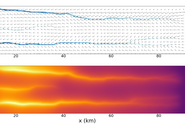
Research in eternal ice: glaciers and polar ice sheets ¶
Alpine glaciers are a hallmark of our landscape and play an important role in hydroelectric power and the local drinking water supply. Like the polar regions, they are acutely affected by global warming. We study these regions in order to anticipate future developments.
Inhalt ¶
Changing climatic conditions in the polar regions affect the global climate. This is because ocean currents, which regulate the climate, depend on the exchange of heat between the polar and tropical regions. The polar snowpacks also play a major role in the global climate, as they reflect around 90% of sunlight. By way of comparison, seawater only reflects around 30% back into space.
We examine the Antarctic and Arctic snowpack during expeditions to the southernmost continent and to Greenland. Understanding how snow turns into ice enables us to reconstruct climate history more reliably than before.
Using automatic measuring stations, we record weather and wind data in East Antarctica. This allows us to determine how much snow has been deposited and in which locations. All of this data is fed into "Snowpack", our snowpack and radiation balance model, and improves existing climate models.
Swiss Polar Institute founded ¶
In order to pool expertise in polar research, we founded the Swiss Polar Institute in 2016 together with four other institutions. The aim of the Institute is to promote research of the poles and extreme regions.
What are the consequences of ice-free Alps? ¶
We also examine and observe Alpine glaciers. Researchers have calculated that they will largely melt by the end of the century. We study the impact that this will have on water availability (for drinking water, hydroelectric power, and irrigation). We also use computer models to simulate the danger of glacial outburst and ice avalanches.
Themen ¶
Contact ¶
WSL Publications ¶
Projects ¶
Links ¶
- Swiss Polar Institute
- Conference report „Polar 2018“, co-organized by SLF, Davos






